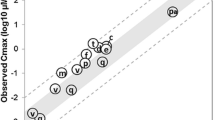Abstract
The clinical efficacy and safety profile of a new medicinal product is established in phase III studies, which are usually restricted to a well defined patient population. This population may not fully represent the population in which the product will be used once it is on the market. Pharmacokinetic studies in special populations are performed to estimate drug exposure in subpopulations of patients with characteristics that may affect drug exposure. The clinical consequences of altered exposure are then assessed, taking pharmacokinetic/pharmacodynamic relationships into consideration. If needed, specific treatment recommendations should be developed.
Recommendations regarding pharmacokinetic characterization in special populations are given in a number of European guidelines. The pharmacokinetic characteristics, therapeutic window and intended use of the medicinal product influence the need for pharmacokinetic studies of a new medicinal product. There are a number of methodological issues to be considered when designing pharmacokinetic studies in special populations: the study design, study population and control group, the dosing regimen to be used, the analytes to be measured, and the distribution and range of the factor to be studied. The data should be presented in sufficient detail to enable assessment by regulatory authorities of the conducted analysis and conclusions drawn. Assessment of the data should include an evaluation of how and to what extent the pharmacokinetics in specific subpopulations deviate from the exposure at the therapeutic dose in the clinical efficacy and safety studies, and if there is a need for specific treatment recommendations. Based on the available information on the pharmacokinetic/pharmacodynamic relationships for efficacy and safety and/or the exposure at the therapeutic dose in the phase III population where efficacy and safety have clinically relevant difference in efficacy and safety. Should the exposure in a specific group fall outside the defined target criteria, appropriate treatment recommendations need to be developed. The aim should be to develop dosing recommendations that will allow the majority of the patients to obtain exposure within the defined target range. If it is not possible to develop suitable dosing recommendations in a subgroup of patients, there may be a need for specific warnings or wordings regarding monitoring of the patients. It may also be an option to exclude that patient group from the indication. The resulting treatment recommendations should ensure safe and effective use of the drug in the entire population for which it has been approved.



Similar content being viewed by others
Notes
By ‘conventional study’, we mean a traditional pharmacokinetic study in volunteers, with extensive blood sampling providing full concentrationtime profiles.
References
European Medicines Agency. Note for guidance: pharmacokinetic studies in man [no. 3CC3A; online]. Available from URL: http://www.emea.europa.eu/pdfs/human/ewp/3cc3aen.pdf [Accessed 2008 Aug 28]
European Medicines Agency Committee for Medicinal Products for Human Use. Note for guidance on the evaluation of the pharmacokinetics of medicinal products in patients with impaired renal function [no. CHMP/EWP/225/02; online]. Available from URL: http://www.emea.europa.eu/pdfs/human/ewp/022502en.pdf [Accessed 2008 Aug 28]
European Medicines Agency Committee for Medicinal Products for Human Use. Guideline on the evaluation of the pharmacokinetics of medicinal products in patients with impaired hepatic function [no. CPMP/EWP/2339/02; online]. Available from URL: http://www.emea.europa.eu/pdfs/human/ewp/233902en.pdf [Accessed 2008 Aug 28]
European Medicines Agency Committee for Medicinal Products for Human Use. Guideline on the role of pharmacokinetics in the development of medicinal products in the paediatric population [no. CHMP/EWP/147013/04; online]. Available from URL: http://www.emea.europa.eu/pdfs/human/ewp/14701304en.pdf [Accessed 2008 Aug 28]
European Medicines Agency Committee for Medicinal Products for Human Use. Reflection paper on the use of pharmacogenetics in the pharmacokinetic evaluation of medicinal products [no. EMEA/128517/2006; online]. Available from URL: http://www.emea.europa.eu/pdfs/human/pharmacogenetics/12851706enfin.pdf [Accessed 2008 Aug 28]
European Medicines Agency Committee for Proprietary Medicinal Products. Note for guidance on studies in support of special populations: geriatrics [no. CPMP/ ICH/379/95; online]. Available from URL: http://www.emea.europa.eu/pdfs/human/ich/037995en.pdf [Accessed 2008 Aug 28]
European Medicines Agency Committee for Proprietary Medicinal Products. Note for guidance on ethnic factors in the acceptability of foreign clinical data (no. CPMP/ICH/289/95; online]. Available from URL: http://www.emea.europa.eu/pdfs/human/ich/028995en.pdf [Accessed 2008 Aug 28]
European Medicines Agency Committee for Medicinal Products for Human Use. Guideline on reporting the results of population pharmacokinetic analyses [no. CHMP/EWP/185990/06; online]. Available from URL: http://www.emea.europa.eu/pdfs/human/ewp/18599006enfin.pdf [Accessed 2008 Aug 28]
Bergquist C, Lindegård J, Salmonson T. Dosing recommendations in liver disease. Clin Pharmacol Ther 1999 Aug; 66(2): 201–4
Acknowledgements
Permission to use the figures in the example has kindly been given by Bristol-Meyer Squibb. No funding was provided for the preparation of the paper.
Author information
Authors and Affiliations
Corresponding author
Rights and permissions
About this article
Cite this article
Edholm, M., Berglund, E.G. & Salmonson, T. Regulatory Aspects of Pharmacokinetic Profiling in Special Populations. Clin Pharmacokinet 47, 693–701 (2008). https://doi.org/10.2165/00003088-200847110-00001
Published:
Issue Date:
DOI: https://doi.org/10.2165/00003088-200847110-00001




